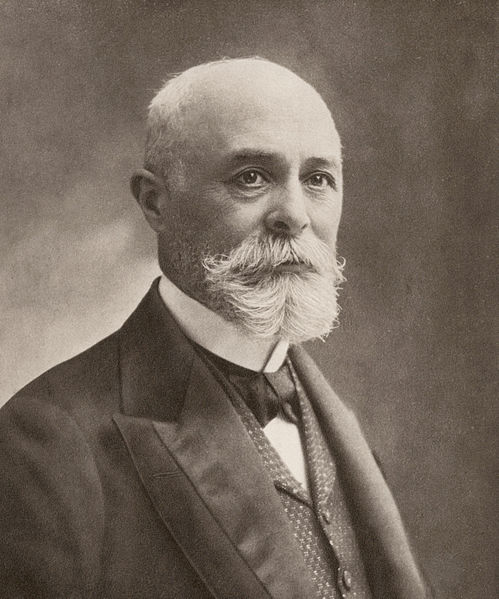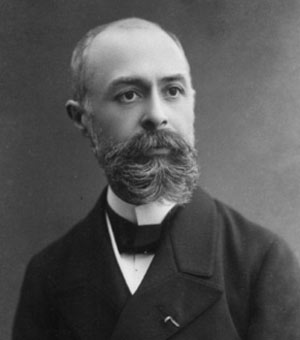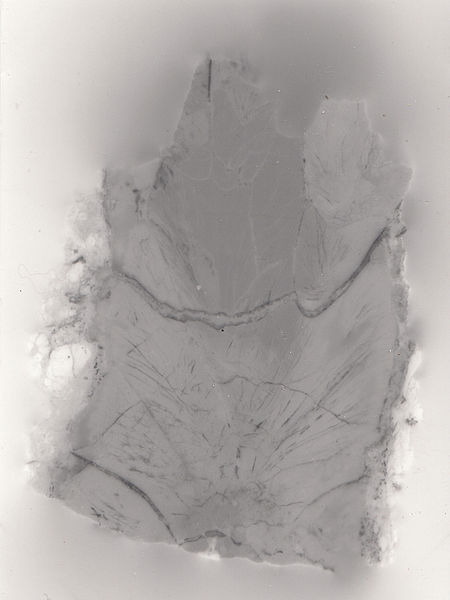<Back to Index>
- Physicist Antoine Henri Becquerel, 1852
PAGE SPONSOR



Antoine Henri Becquerel (15 December 1852 – 25 August 1908) was a French physicist, Nobel laureate, and the discoverer of radioactivity along with Marie Skłodowska - Curie and Pierre Curie, for which all three won the 1903 Nobel Prize in Physics.
Becquerel was born in Paris into a family which produced four generations of scientists, including Becquerel's own son Jean. He studied engineering at the École Polytechnique and the École des Ponts et Chaussées. In 1890 he married Louise Désirée Lorieux.
In 1892, he became the third in his family to occupy the physics chair at the Muséum National d'Histoire Naturelle. In 1894, he became chief engineer in the Department of Bridges and Highways.
Becquerel's discovery of radioactivity is a famous example of serendipity, of how chance favors the prepared mind. Becquerel had long been interested in the phosphorescence, the emission of light of one color following a body's exposure to light of another color. In early 1896, in the wave of excitement following Wilhelm Conrad Röntgen's discovery of X-rays the previous fall, Becquerel thought that phosphorescent materials, such as some uranium salts, might emit penetrating X-ray ike radiation when illuminated by bright sunlight. His first experiments appeared to show this.
Describing them to the French Academy of Sciences on 24 February 1896, he said:
One wraps a Lumière photographic plate with a bromide emulsion in two sheets of very thick black paper, such that the plate does not become clouded upon being exposed to the sun for a day. One places on the sheet of paper, on the outside, a slab of the phosphorescent substance, and one exposes the whole to the sun for several hours. When one then develops the photographic plate, one recognizes that the silhouette of the phosphorescent substance appears in black on the negative. If one places between the phosphorescent substance and the paper a piece of money or a metal screen pierced with a cut - out design, one sees the image of these objects appear on the negative ... One must conclude from these experiments that the phosphorescent substance in question emits rays which pass through the opaque paper and reduce silver salts.
But further experiments led him to doubt and then abandon this hypothesis. On 2 March 1896 he reported
I will insist particularly upon the following fact, which seems to me quite important and beyond the phenomena which one could expect to observe: The same crystalline crusts [of potassium uranyl sulfate], arranged the same way with respect to the photographic plates, in the same conditions and through the same screens, but sheltered from the excitation of incident rays and kept in darkness, still produce the same photographic images. Here is how I was led to make this observation: among the preceding experiments, some had been prepared on Wednesday the 26th and Thursday the 27th of February, and since the sun was out only intermittently on these days, I kept the apparatuses prepared and returned the cases to the darkness of a bureau drawer, leaving in place the crusts of the uranium salt. Since the sun did not come out in the following days, I developed the photographic plates on the 1st of March, expecting to find the images very weak. Instead the silhouettes appeared with great intensity ... One hypothesis which presents itself to the mind naturally enough would be to suppose that these rays, whose effects have a great similarity to the effects produced by the rays studied by M. Lenard and M. Röntgen, are invisible rays emitted by phosphorescence and persisting infinitely longer than the duration of the luminous rays emitted by these bodies. However, the present experiments, without being contrary to this hypothesis, do not warrant this conclusion. I hope that the experiments which I am pursuing at the moment will be able to bring some clarification to this new class of phenomena.
By May 1896, after other experiments involving non - phosphorescent uranium salts, he arrived at the correct explanation, namely that the penetrating radiation came from the uranium itself, without any need of excitation by an external energy source.
There followed a period of intense research in radioactivity, including the discovery of additional radioactive elements thorium, polonium and radium, the latter two by Becquerel's doctoral student Marie Curie and her husband Pierre Curie.
In 1903, Becquerel shared the Nobel Prize in Physics with Pierre and Marie Curie "in recognition of the extraordinary services he has rendered by his discovery of spontaneous radioactivity".
As often happens in science, radioactivity came close to being discovered nearly four decades earlier when, in 1857, Abel Niepce de Saint - Victor, who was investigating photography under Michel Eugène Chevreul, observed that uranium salts emitted radiation able to darken photographic emulsions. By 1861, Niepce de Saint - Victor realized that uranium salts produce "a radiation that is invisible to our eyes". (Note that Niepce de Saint - Victor knew Edmond Becquerel, Henri Becquerel's father.)
In 1908, the year of his death, Becquerel was elected Permanent Secretary of the Académie des Sciences. He died at the age of 55 in Le Croisic.
The SI unit for radioactivity, the becquerel (Bq), is named after him. There is a crater called Becquerel on the Moon and also a crater called Becquerel on Mars.
He also received the following awards besides the Nobel Prize for Physics (1903):
- Rumford Medal (1900)
- Helmholtz Medal (1901)
- Barnard Medal (1905)